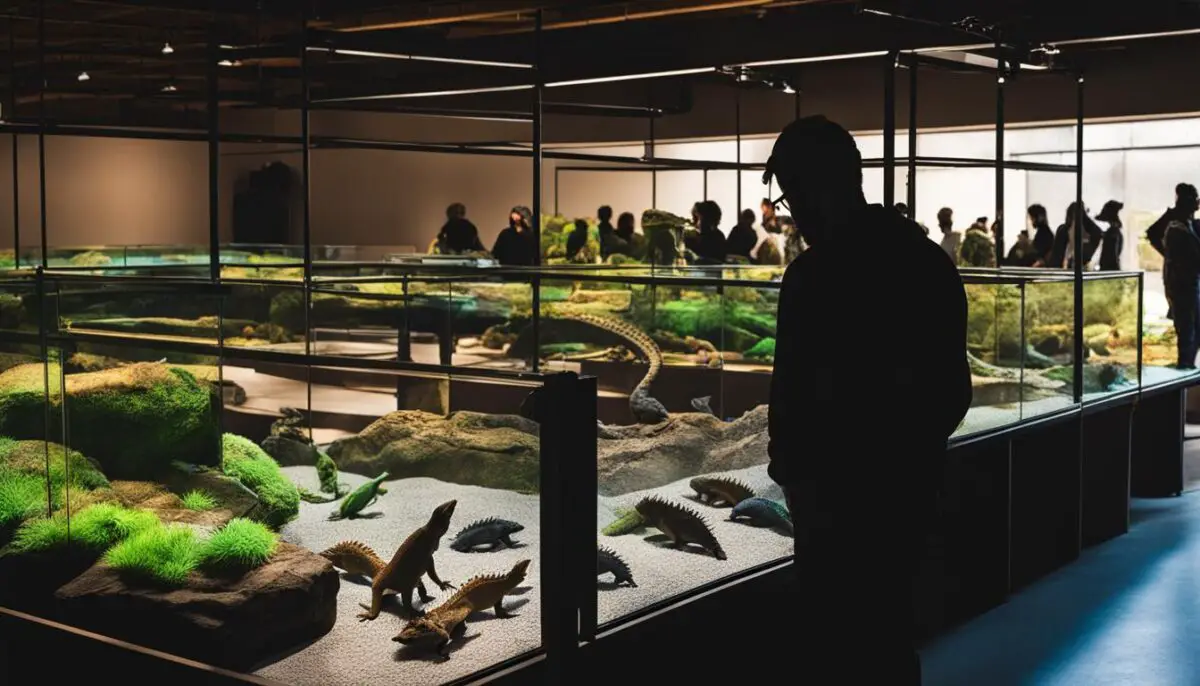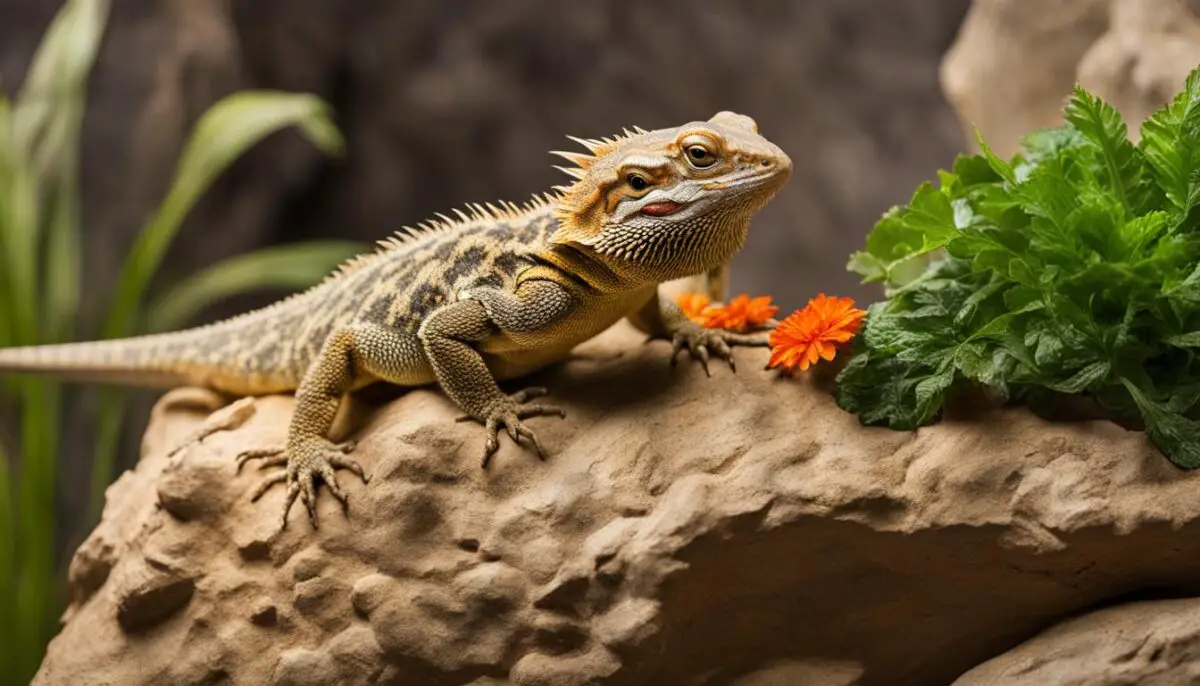Bearded dragons, native to the arid Australian deserts, are curious and active reptiles that require special care and attention. One of the most common health issues they face is obesity, which can lead to various complications. To ensure the well-being of your bearded dragon, it is important to provide them with a balanced diet and regular exercise, while also taking preventive measures to avoid obesity-related illnesses.
Consulting with a veterinarian is crucial to determine the specific needs of your dragon. Adult bearded dragons should have a diet consisting of 80% plants and 20% insects, with variations based on their age. Feeder insects like crickets, dubia roaches, and worms are popular choices, while vegetables such as dark leafy greens, squash, and bell peppers provide them with the necessary plant intake. It is important to steer clear of toxic insects and plants that can harm their health.
Additionally, bearded dragons require access to clean water, proper hydration, and supplements like calcium and vitamin D3. Creating a suitable habitat with a spacious terrarium, appropriate heat sources, and UVB lighting is essential for their well-being. Tank accessories like covers, lighting fixtures, and hiding areas provide them with enrichment and promote their overall health.
When choosing a bearded dragon, consider reputable sources such as pet stores, breeders, and reptile rescues. Look for signs of good health and ensure that the dragon has been properly cared for before making a purchase. Young dragons may require more care and attention compared to adults, so choose one that suits your preferences and level of commitment.
Proper feeding and nutrition are paramount for the well-being of bearded dragons. Their diet should consist of a balance between insects and vegetables, with young dragons requiring more insect protein and adult dragons needing a higher vegetable intake. Dusting insects with calcium and providing vitamin supplements ensure their proper nutrition and prevent deficiencies.
Key Takeaways:
- Obesity can be a serious health issue in bearded dragons, leading to various complications.
- A well-balanced diet consisting of 80% plants and 20% insects is essential for their health.
- Choosing a healthy dragon from reputable sources is important.
- Creating a suitable habitat with proper lighting and heating is crucial for their well-being.
- Dusting insects with calcium and providing vitamin supplements ensure their proper nutrition.
Choosing a Bearded Dragon: Tips and Considerations
When it comes to bringing a bearded dragon into your life, you have several options to choose from. Whether you prefer pet stores, breeders, classified ads, or reptile rescues, there are various avenues to find your new scaly companion. However, it is essential to consider the health and well-being of the dragon before making a purchase or adoption.
When examining potential bearded dragons, keep an eye out for any signs of past injuries or missing body parts. These could indicate previous health issues and may require special care. On the other hand, look for signs of good health, such as alertness, bright eyes, and an active demeanor. A healthy bearded dragon should be curious, responsive, and display a vibrant appearance.
Furthermore, it is crucial to ensure that the seller or breeder you choose is reputable and has a history of properly caring for their reptiles. Research and read reviews to learn about their practices, as this will give you confidence in their knowledge and ethics. A reputable source will provide you with a healthy bearded dragon that has been well-maintained, properly fed, and given appropriate veterinary care.
Consider the age of the bearded dragon as well. Young dragons require more attention and care compared to older ones. They have specific needs concerning diet, lighting, and temperature regulation, so be prepared to provide the necessary care and guidance that a younger dragon may require.
Ultimately, the choice of a bearded dragon should align with your preferences and lifestyle. Choose a dragon that captures your heart and is healthy, ensuring that you will have a rewarding and lasting connection. Remember, the journey of caring for a bearded dragon begins with selecting a suitable companion.

“Choosing a bearded dragon is an exciting process, but it’s crucial to prioritize their well-being. By selecting a healthy dragon from a reputable source, you can provide a loving home and enjoy the companionship of these remarkable creatures.”
Creating the Perfect Habitat for Your Bearded Dragon
When it comes to housing your bearded dragon, providing a spacious and suitable habitat is essential for their well-being. A well-designed tank will not only ensure their physical comfort but also promote their mental stimulation. Here are some key considerations for creating the perfect habitat:
Tank Size
Bearded dragons require a tank large enough to accommodate their active nature. While the minimum recommended tank size for adult dragons is a 75-gallon tank, it is advisable to invest in a larger tank if possible. This will allow your dragon more room to roam and explore, promoting their overall health and happiness.
Ventilation and Temperature Gradient
Proper ventilation is crucial for maintaining a healthy environment inside the tank. Make sure the tank has a screen top to allow for adequate airflow. Additionally, create a temperature gradient within the tank by placing heat sources on one side and leaving the other side cooler. This enables your dragon to regulate their body temperature and find the perfect spot for comfort.
UVB Lighting and Heat Sources
Bearded dragons require UVB lighting for the synthesis of vitamin D3 and calcium absorption. Ensure the tank is equipped with a suitable UVB light fixture that spans the length of the tank. It’s also important to provide heat sources like ceramic heat emitters or basking bulbs to create warm areas within the tank for your dragon’s thermoregulation needs.
Safe Substrates
Choosing the right substrate for your bearded dragon’s tank floor is crucial to prevent ingestion and impaction risks. Opt for substrates like tile, newspaper, or indoor/outdoor carpeting, which are safe and easy to clean. Avoid loose substrates such as sand or gravel, as they can be accidentally ingested and cause digestive issues.
Tank Accessories
To enhance your bearded dragon’s habitat, consider adding various tank accessories. These can include hides or caves for them to retreat to, climbing branches or rocks to provide exercise and enrichment, and even hammocks for relaxation. Adding tank accessories not only mimics their natural environment but also promotes physical and mental stimulation.
Creating the perfect habitat for your bearded dragon is essential for their overall health and well-being. By providing a spacious tank with appropriate ventilation, temperature gradients, UVB lighting, and safe substrates, you can ensure a comfortable and stimulating environment for your beloved pet. Adding tank accessories further enhances their habitat, making it a truly enriching space for your bearded dragon to thrive in.
Proper Feeding and Nutrition for Bearded Dragons
Bearded dragons are omnivores, meaning they require a well-balanced diet consisting of both insects and vegetables to meet their nutritional needs. It’s important to provide the right foods in the appropriate proportions for their age and development.
Foods for Bearded Dragons
When it comes to feeding bearded dragons, the ideal diet varies depending on their life stage. Juvenile dragons, which are younger than one year old, have higher protein requirements and should be fed more insects. Crickets, dubia roaches, and worms make excellent choices for their insect intake. On the other hand, adult bearded dragons have lower protein requirements and should consume more plant matter. Dark leafy greens like romaine lettuce and kale, as well as vegetables such as carrots and squash, are suitable options for their plant intake. Fruits should be given sparingly as treats, as they contain higher sugar content. Avoid feeding your dragon toxic insects and plants to prevent any health issues.
Frequency of Feeding Bearded Dragons
The frequency of feeding a bearded dragon depends on its age. Adult dragons can typically be fed every 24-48 hours, while juvenile dragons may need to eat more frequently, about once or twice a day. It’s essential to monitor their weight and overall health to adjust their feeding schedule accordingly.
Insect Calcium and Multivitamin Dusting
In addition to providing a varied diet, it’s important to ensure your bearded dragon receives the necessary vitamins and minerals. Dusting insects with calcium and providing multivitamin supplements is crucial to prevent nutrient deficiencies. Calcium is essential for their bone health, and a lack of it can lead to metabolic bone disease. Multivitamin supplements help to meet their overall vitamin requirements. Consult with a reptile veterinarian to determine the appropriate supplementation schedule and dosage for your dragon.
Conclusion
Taking care of obese bearded dragons requires careful consideration of their diet, housing, and overall health. Providing a well-balanced diet and regular exercise can help prevent and treat obesity-related illnesses. By feeding your dragon a combination of nutritious insects and vegetables, you can ensure they receive the essential nutrients they need. It is also important to create a suitable habitat with proper lighting, heating, and enrichment to promote their well-being and natural behaviors.
Choosing a healthy dragon from reputable sources is crucial. Look for breeders or sellers who have a good reputation for providing well-cared-for dragons. Regular check-ups with a veterinarian ensure that any health issues are identified and treated promptly.
Lastly, proper supplementation with calcium and vitamin D3 is important for maintaining your dragon’s overall health. These nutrients are needed for proper bone development and metabolism.
By following these guidelines and giving your bearded dragon the care it needs, you can ensure that it leads a happy, healthy life and enjoys a long, fulfilling lifespan.
FAQ
What are the health issues in bearded dragons as a result of obesity?
Obesity in bearded dragons can lead to various health issues, including fatty liver disease, respiratory problems, reduced lifespan, and decreased mobility.
How can I prevent obesity in my bearded dragon?
To prevent obesity in bearded dragons, provide them with a balanced diet consisting of 80% plants and 20% insects, along with regular exercise and an appropriately sized habitat.
What diet should I follow to treat obesity in my bearded dragon?
For obese bearded dragons, reduce the insect portion of their diet and increase the vegetable portion. Feed them nutrient-rich vegetables and limit high-fat and sugary foods. Consult with a veterinarian for a customized diet plan.
How can I exercise my overweight bearded dragon?
Encourage exercise in overweight bearded dragons by providing climbing structures, obstacles, and encouraging active playtime outside of the tank under supervision.
How often should I take my bearded dragon to the veterinarian?
Regular veterinary check-ups are essential for bearded dragons. They should have an annual wellness exam to monitor their overall health and detect any potential issues early on.
Where can I get a healthy bearded dragon?
You can find healthy bearded dragons from reputable sources such as pet stores, breeders, classified ads, and reptile rescues. Ensure the dragon is in good health, alert, and active before making a purchase.
What should I consider when choosing a bearded dragon?
When choosing a bearded dragon, consider their health, activity level, and age. Look for signs of past injuries or good health indicators, and choose a dragon that suits your preferences and level of care requirements.
What is the recommended tank size for bearded dragons?
Bearded dragons require spacious terrariums, with a minimum size of a 75-gallon tank for adults. However, a larger tank is recommended to provide ample space for their activities and enrichment.
What should I include in the bearded dragon habitat?
The bearded dragon habitat should include a screen top for ventilation, proper temperature gradients, UVB lighting for calcium absorption, suitable heat sources, safe substrates like tile or indoor/outdoor carpeting, and tank accessories such as covers, hiding areas, and climbing structures.
What should I feed my bearded dragon?
Bearded dragons are omnivores and should be fed a diet comprised of 80% plants and 20% insects for adult dragons. Feeder insects like crickets, dubia roaches, and worms, along with vegetables like dark leafy greens, squash, and bell peppers, are suitable options. Fruits should be given sparingly as treats.



